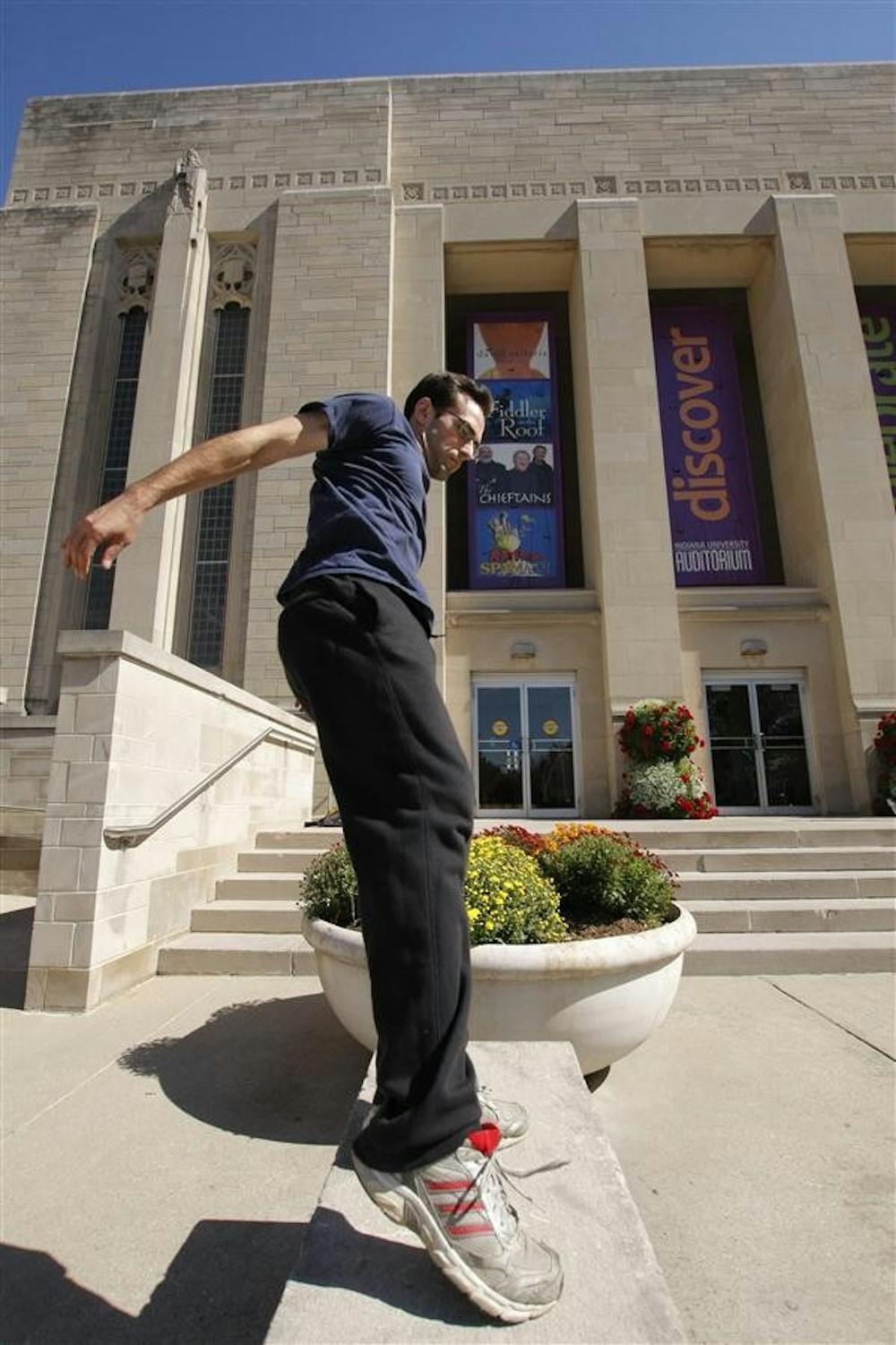Eric Joyal and Joey Leveille relax and exhale, exchanging sideways glances.
A quick nod is followed by a burst of motion. Then, the sophomores’ bodies are parallel with the ground as they run up the trunk of a tree. Upside down with heels pointed to the sky, Leveille accidentally kicks a branch, cracking it.
As leaves cascade and settle around them, the traceurs — a French term for practitioners of parkour — land in a seemingly effortless fashion, raise their heads and grin.
Six students and a professor met for the first time in 2008 behind Herman B Wells Library to share an uncommon set of skills — scaling walls, jumping across elevated gaps and flipping off of anything wide enough to get a footing.
More than two years have passed, and they’re still training every Saturday with the recently endowed title IU’s Parkour Student Organization.
“Parkour is a discipline of movement, similar to a martial art,” senior Niles Burke said. “It’s about overcoming obstacles and getting from point A to point B in the most efficient and direct way possible.”
Burke is one of the group’s founding members who are working to make the groups move from a student organization to a Recreational Sports Club. The move will allow the group to receive student funds and the right to reserve training equipment and rooms in the School of Health, Physical Education, and Recreation with
gymnastic pads.
***
“When we first started out, campus didn’t know who we were,” Burke said.
Most still don’t.
Run-ins with IU Police Department are rare, but from time-to-time, concerned citizens have called in complaints claiming students were vandalizing buildings or scaling large walls and walking on rooftops.
Several IUPD officers have asked the group to disband following complaints. However, at least one officer who expressed interest in the discipline has trained with them in the past.
“Our concern would first be any behavior that would be reckless that could likely cause injury to self or others,” Chief of Police Keith Cash said.
Injuries happen, but injuries are also ignored.
Programs such as MTV’s “Ultimate Parkour Challenge” have exposed American audiences to parkour, but practitioners have said it’s not enough to break cultural stigmas regarding the use of public space.
That’s where community service comes in.
As a “thank you” to the University for reinstating their student organization status, the group will have an open event, “Leave No Trace,” from noon to 4 p.m. Saturday behind the Wells Library. Interested students can learn the basics of parkour and train in a group setting while picking up trash and scrubbing scuff marks off the building’s limestone walls.
“In the environments we use, sometimes we might chip a ledge, and we really don’t want to mess up what we train on,” Burke said. “We don’t want people to think we’re vandalizing.”
The phrase “Leave No Trace” might ring a bell for campers, rock climbers and outdoorsman alike. Now, with the work of an online community, American Parkour, “Leave No Trace” is becoming an important part of parkour training.
American Parkour, which emphasizes community involvement to promote a better public understanding of parkour and freerunning — the more eye-catching cousin to parkour — tracks the number of bags of trash removed from community spaces
by traceurs.
Adam Noble, an assistant professor of movement/combat for the Department of Theatre & Drama, has been training on and off with the organization since day one. If the parkour organization is granted RS Club status, he intends to serve as their academic adviser.
“I have never met traceurs who don’t care about their environment or community,” Noble said.
A key goal of parkour is to move effortlessly through one’s environment, and in principle that effortless movement carries over into community relations.
“We want to show that we’re not just reckless teenagers who are going to hurt themselves,” Joyal said. “We aren’t just a liability. We’re serious about what
we do.”
***
Part of what they “do” is teach, and Burke said IU offers an open environment for beginners.
Executing new techniques for the first time with the guidance of more experienced practitioners is a luxury that the group’s founding members didn’t have — without teachers, they relied on YouTube videos and high thresholds for pain to learn the basics.
“Having another, more experienced member there to give you pointers or to break down the steps of a move — that can be the difference between getting it right and getting an injury,” Noble said.
Parkour practices begin with introductions and stretching, followed by beginner techniques.
Wall runs come first.
Newcomers are taught to run at sheer wall faces, propelling themselves vertically with a well-placed kick that lands them atop a ledge.
“I thought it would be scary to do this, especially outside,” freshman Meghane Masquelin said during her second practice. “It was raining last weekend, and we were inside with mats and everything like that.”
Meanwhile, others practice tic tacs and precision exercises. Before long, they’re flipping, walking on their hands and hurdling across a limestone landscape that begins to take on new form. A simple pedestrian space is no longer used for loitering and idle chitchat — campus becomes a proverbial jungle gym.
Limestone, Burke said, offers an excellent gripping surface without sacrificing one’s hands, and with plenty of varied surfaces on the University’s monolithic architecture, makes campus a superb parkour stomping-ground.
Without official organizations to model themselves after and RS Club status on the horizon, the founding members of IU’s first parkour organization are working to coordinate themselves in ways that are still novel in the U.S. to ensure a future for the discipline on campus.
“Since most of us who started this are seniors, it’s nice to know that it’ll continue on once we leave,” Burke said. “That’s why we want to get club status, so that it doesn’t fall apart after
we’re gone.”
Parkour group scales, jumps, flips

Get stories like this in your inbox
Subscribe





